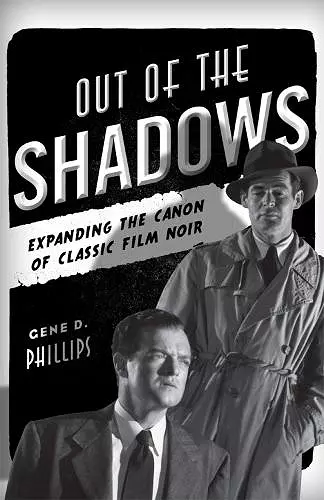Out of the Shadows
Expanding the Canon of Classic Film Noir
Format:Hardback
Publisher:Scarecrow Press
Published:3rd Nov '11
Currently unavailable, and unfortunately no date known when it will be back

Film noir was a cycle in American cinema which first came into prominence during World War II, peaked in the 1950s, and began to taper off as a definable trend by 1960. Over the years, a group of films from the period emerged as noir standards, beginning with Stranger on the Third Floor in 1940. However, since film noir is too wide-ranging, it cannot be kept within the narrow limits of the official canon that has been established by film historians. Consequently, several neglected movies made during the classic noir period need to be re-evaluated as noir films. In Out of the Shadows: Expanding the Canon of Classic Film Noir, Gene Phillips provides an in-depth examination of several key noir films, including acknowledged masterpieces like Laura, The Maltese Falcon, Sunset Boulevard, and Touch of Evil, as well as films not often associated with film noir like Spellbound, A Double Life, and Anatomy of a Murder. Phillips also examines overlooked or underappreciated films such as Song of the Thin Man, The Glass Key, Ministry of Fear, and Act of Violence. Also considered in this reevaluation are significant neo-noir films, among them Chinatown, Hammett, L.A. Confidential, and The Talented Mr. Ripley. In his analyses, Phillips draws upon a number of sources, including personal interviews with directors and others connected with their productions, screenplays, and evaluations of other commentators. Out of the Shadows explores not only the most celebrated noir films but offers new insight into underrated films that deserve reconsideration. Of interest to film historians and scholars, this volume will also appeal to anyone who wants a better understanding of the works that represent this unique cycle in American filmmaking.
World War II and the increased public acceptance of psychiatry in the 1940s led to the rise of a new film genre, film noir. Noir was marked by convoluted story lines; seamy settings; hard-boiled, morally compromised antiheroes; and scheming, manipulative femmes fatales. Phillips (Some Like It Wilder: The Life and Controversial Films of Billy Wilder) writes that key noir films have been neglected or overlooked, notably Otto Preminger’s courtroom drama Anatomy of a Murder and Alfred Hitchcock’s Spellbound. He examines elements that define a noir film and the role of expatriate directors like Fritz Lang and Billy Wilder, who fled Hitler’s Europe but brought their dark visions with them. Essays cover major themes, give little-known facts about the making of the films, and offer critical insights. Although film noir mostly petered out in the 1950s, Phillips also describes more recent neonoir classics, including Body Heat, L.A. Confidential, and Chinatown. Solid research and extensive cast and director interviews....Consistently readable and engaging, it will still have strong appeal for film noir fans. * Library Journal *
Film historian and biographer Phillips suggests that the accepted film noir canon is perhaps too narrowly defined. Noir, as applied by most film historians, excludes some very worthy films, such as Hitchcock’s Strangers on a Train and Fritz Lang’s Ministry of Fear, as well as more modern offerings such as Anthony Minghella’s The Talented Mr. Ripley. Of Ministry of Fear, for example, Phillips suggests that it is not merely a minor Lang movie; it is an important and overlooked noir film. And, as with all the films discussed, he goes into a good amount of detail, exploring the movie’s themes, characters, and dialogue and showing how each belongs in the noir canon. The book apparently had a long gestation period; it draws on interviews with several directors who have been dead for decades—Lang, Cukor, Wilder, Hitchcock, and Kubrick (whose own 1956 film, The Killing, was, Phillips says, unappreciated in its time). Phillips isn’t suggesting a major overhaul of the genre, but he is saying that it’s time we look again at film noir with fresh eyes. A valuable addition to any film-book library. * Booklist *
Although one can find numerous books on the topic of film noir and treatments of seemingly every possible angle on the subject, Phillips somehow manages to add one more dimension to the study of the genre. He does so by "expanding the canon" of film noir to include films often overlooked, noting the importance and significance of films such as Alfred Hitchcock's Strangers on a Train, Otto Preminger's Anatomy of a Murder, and Orson Welles's The Stranger to the cycle of films produced during the film noir era. In a thoughtful, jargon-free style, the author provides concise histories, synopses, and analyses of 23 films, combining personal interviews with primary and secondary research. Moreover, he includes information about authors of hard-boiled fiction, such as Dashiell Hammett, James Cain, Raymond Chandler, and Patricia Highsmith, continually connecting film noir to its literary roots. Phillips's breezy, conversational style makes for quick reading and easy accessibility to a topic often convoluted. For those interested in a historical and literary perspective on film noir, this volume fulfills the requirement and will not disappoint. Summing Up: Recommended. Lower-division undergraduates through faculty; general readers. * CHOICE *
The book is an easy read and it is the analysis of two juxtaposing films in each chapter that makes the book interesting. . . .[It] does make a good . . . academic study of the genre. * Filmwerk *
ISBN: 9780810881891
Dimensions: 238mm x 164mm x 28mm
Weight: 621g
322 pages